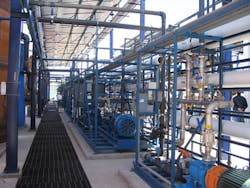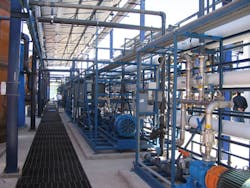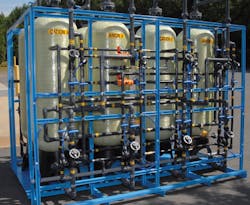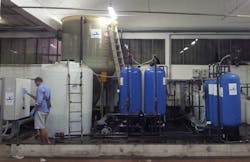By Jeff Gunderson
Industrial surface finishing operations, including plating, polishing, anodizing, and coating, serve a vital role in the manufacturing economy by enhancing the appearance and functional property of constructed and assembled goods. Employed across a wide range of industrial sectors -- from electronics, automotive and shipbuilding to medical, heavy equipment and many others -- surface finishing processes can add durability, improve resistance, remove imperfections, or modify the electrical conductivity of manufactured products.
Surface finishing wastewaters are characteristically non-organic, complex, and can be highly varied, with elevated concentrations of contaminants and heavy metals, presenting a number of challenges in terms of treatment.
"One of the biggest issues in treating surface finishing wastewater relates to the need to deal with mixed waste streams generated from multiple processes," said Kyle Hankinson, president of Forest City, N.C.-based KCH Engineered Systems, a provider of comprehensive solutions for industrial air and water pollution control. "These wastewaters can contain a diversity of metals, pollutants and varied chemistries, often making treatment difficult."
According to Hankinson, increasingly demanding discharge regulations represent another ongoing significant challenge for surface finishing operations, which continues to drive the adoption of more advanced treatment technologies in this space.
With metals under growing regulatory scrutiny, wastewaters from metal finishing operations could soon be subject to revised federal discharge guidelines. According to the National Association for Surface Finishing (NASF), the Environmental Protection Agency (EPA) has solicited data and other information from the metal finishing industry pertaining to the discharge and treatment of a range of metals including chromium, nickel, zinc, cadmium, copper, lead, and silver.
While the NASF has indicated that it is not clear whether or not the metal finishing effluent limitation guidelines will be revised in the near future, the EPA issued its Preliminary 2014 Effluent Guidelines Program Plan in September of last year, which stated that a preliminary category review of the metal finishing point source category will continue and that its recent review of this category suggests that discharges of metals and other potentially hazardous pollutants are of increasing concern.
Greater Focus on Water Recycling
With growing water-shortage risks to industrial operations as a result of increasingly unstable water supplies, more operators in the surface finishing sector are turning to water recycling as a measure for mitigating these risks.
Bill Clark, regional sales manager of Rock Hill, S.C.-based DMP Corporation, a design-build industrial wastewater treatment provider for all facets of the metal finishing industry, explained that strong growth in recycling and reuse systems is particularly evident in water-stressed areas such as the southeastern and southwestern regions of the United States, especially California.
"The current water challenges are really beginning to drive water recycling in the surface finishing industry," Clark said. "In California, water availability for industries could soon be restricted by water allocations. If the water supply is fixed, facilities will be forced to incorporate water recycling in order to maintain or expand their operations. One hundred percent of our proposals for metal finishing operations in California now include recycling measures."
DMP, which first installed a wastewater recycling system in 1972 as part of a government-funded recycling project for a metal finishing application, provides reverse osmosis systems as well as a resin-based technology capable of 97-percent water recovery; the remaining 3 percent is high-salt reject.
"In electroplating and surface finishing operations, much of the time the city water that's available isn't adequate for rinsing applications," Clark said. "So, after making an investment in pretreatment, why give that water away? Instead, a facility can treat and remove the contamination that went into the water from their operations and reuse it again."
Considering rising water prices, costs associated with pretreatment and the benefits of automation that continue to reduce operating expenses, Clark noted that water recycling makes more economic sense now than ever before. Additionally, a combination of state, county and city tax credits are available in some jurisdictions for facilities installing recycling systems, providing further economic incentive.
"It's possible to receive 40 percent of [the] capitalization credit if a recycling rate of 60 percent or higher can be achieved," Clark said. "With this type of financial incentive, the investment payback period can be cut in half."
Closing the Loop on Chromium
In treating surface finishing wastewater streams with high metal concentrations, the most common treatment method includes the use of chemical precipitation, where the pH of wastewater is adjusted with an alkaline reagent, rendering dissolved metals insoluble.
As an alternative to this standard approach, a water technology company based out of Israel has developed a unique treatment process for addressing metal-laden surface finishing wastewaters, employing a chemical modification of traditional activated carbon, which allows for the selective removal of target metals using the principles of ion exchange.
ToxSorb, which recently expanded operations to the U.S., specializes in the design, construction and operation of customized filtration systems using its proprietary Modified Activated Carbon (MAC) media. Each MAC platform is engineered for selectivity and affinity towards a specific pollutant while ignoring non-essential molecules in the water. Highly adaptable to each unique application, the MAC technology can be configured for zero liquid discharge and end-of-pipe as well as for the recovery of high-value metals such as nickel, copper and silver.
A core application for MAC involves the selective absorption and reduction of chromium, without the use of traditional chemicals like sodium meta-bisulfite and sulphuric acid, said Ben Perlman, vice president of business development with ToxSorb. "The bottom line is that we're reducing chromium without increasing the salinity in the water," he said. "This is advantageous when your objective is zero liquid discharge and reuse back to the plating process."
During the treatment process, the modifier on the MAC media acts as a catalyst for the reduction of hexavalent chromium to trivalent chromium, facilitating the generation and reuse of the media, according to Perlman.
"In many cases, we're simply closing the loop and eliminating the need for freshwater purchase and wastewater disposal," he said. "And, since less salts are used in the treatment process, less sludge is produced, which minimizes haulage fees. Each of these elements add up to real cost savings over time."
About the Author: Jeff Gunderson is a correspondent for Industrial WaterWorld. He is a professional writer with over 10 years of experience, specializing in areas connected to water, environment and building, including wastewater, stormwater, infrastructure, natural resources, and sustainable design. He holds a master's degree in environmental science and engineering from the Colorado School of Mines and a bachelor's degree in general science from the University of Oregon.





